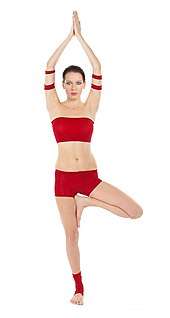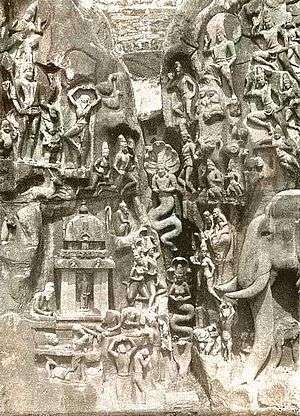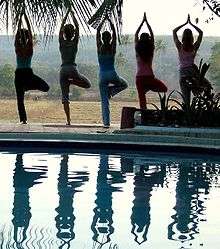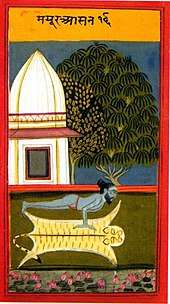Vriksasana
Vrikshasana (Sanskrit: वृक्षासन; IAST: vṛkṣāsana) or Tree Pose[1] is a balancing asana. It is one of the very few standing poses in medieval hatha yoga, and remains popular in modern yoga as exercise.[2]

Etymology and origins

The name comes from the Sanskrit words vṛkṣa (वृक्ष) meaning "tree",[4] and āsana (आसन) meaning "posture".[5]
A 7th-century stone carving in Mahabalipuram appears to contain a figure standing on one leg, perhaps indicating that a pose similar to vrikshasana was in use at that time. It is said that sadhus disciplined themselves by choosing to meditate in the pose.[3]
The pose is described in the 17th century Gheraṇḍa Saṃhitā 2.36.
Description

From Tadasana, weight is shifted to one leg, for example, starting with the left leg. The entire sole of the foot remains in contact with the floor. The right knee is bent and the right foot placed on the left inner thigh, or in half lotus position. In either foot placement, the hips should be open, with the bent knee pointing towards the side. With the toes of the right foot pointing directly down, the left foot, center of the pelvis, shoulders and head are all vertically aligned. Hands are typically held above the head either pointed directly upwards and unclasped, or clasped together in anjali mudra. The asana is typically held for 20 to 60 seconds, returning to tadasana while exhaling, then repeating standing on the opposite leg.[6]
Variations
In Bikram Yoga, Tree Pose (called "Tadasana" in Bikram Yoga) is a slightly different standing posture, with one leg folded in Padmasana and the hands together over the chest in prayer position. It is followed by bending the straight leg into a squatting position (called Toe Stand or "Padangustasana" in Bikram Yoga) with the heel raised and the thigh resting on the calf and heel, the other leg remaining in (half) Padmasana.[7]
See also
References
- "Tree Pose". Yoga Journal. Retrieved 27 January 2019.
- Iyengar 1979, p. 62.
- Krucoff, Carol (28 August 2007). "Find Your Roots in Tree Pose". Yoga Journal.
- "Urdhva Vrikshasana - AshtangaYoga.info". Retrieved 2011-04-11.
- Sinha, S. C. (1 June 1996). Dictionary of Philosophy. Anmol Publications. p. 18. ISBN 978-81-7041-293-9.
- Mehta 1990, p. 21.
- "The 26 Bikram Hot Yoga Postures". Sadhana Yoga & Wellbeing. Retrieved 9 May 2019.
Sources
- Iyengar, B.K.S. (1979). Light on Yoga (Revised ed.). Schocken Books. ISBN 978-0-8052-1031-6.CS1 maint: ref=harv (link)
- Mehta, Silva; Mehta, Mira; Mehta, Shyam (1990). Yoga: The Iyengar Way. Dorling Kindersley.CS1 maint: ref=harv (link)
Further reading
- Saraswati, Swami Janakananda (1 February 1992). Yoga, Tantra and Meditation in Daily Life. Weiser Books. ISBN 978-0-87728-768-1.
- Saraswati, Swami Satyananda (1 August 2003). Asana Pranayama Mudra Bandha. Nesma Books India. ISBN 978-81-86336-14-4.
- Saraswati, Swami Satyananda (January 2004). A Systematic Course in the Ancient Tantric Techniques of Yoga and Kriya. Nesma Books India. ISBN 978-81-85787-08-4.
_from_Jogapradipika_1830_(detail).jpg)

